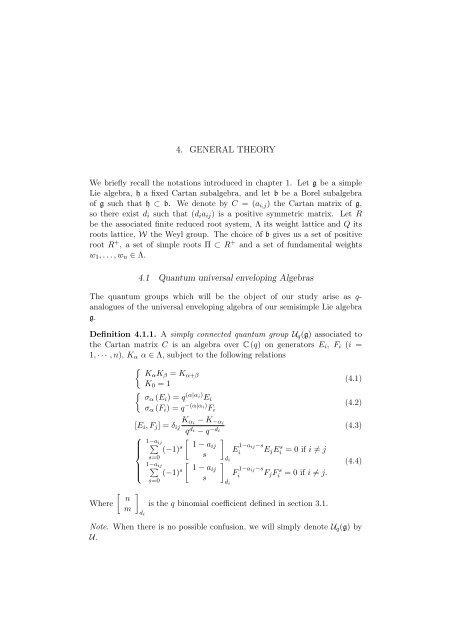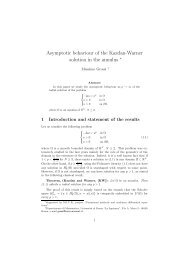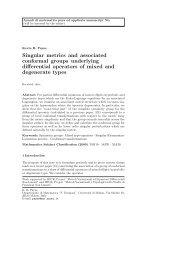Degree of Parabolic Quantum Groups - Dipartimento di Matematica ...
Degree of Parabolic Quantum Groups - Dipartimento di Matematica ...
Degree of Parabolic Quantum Groups - Dipartimento di Matematica ...
Create successful ePaper yourself
Turn your PDF publications into a flip-book with our unique Google optimized e-Paper software.
4. GENERAL THEORY<br />
We briefly recall the notations introduced in chapter 1. Let g be a simple<br />
Lie algebra, h a fixed Cartan subalgebra, and let b be a Borel subalgebra<br />
<strong>of</strong> g such that h ⊂ b. We denote by C = (ai,j) the Cartan matrix <strong>of</strong> g,<br />
so there exist <strong>di</strong> such that (<strong>di</strong>aij) is a positive symmetric matrix. Let R<br />
be the associated finite reduced root system, Λ its weight lattice and Q its<br />
roots lattice, W the Weyl group. The choice <strong>of</strong> b gives us a set <strong>of</strong> positive<br />
root R + , a set <strong>of</strong> simple roots Π ⊂ R + and a set <strong>of</strong> fundamental weights<br />
w1, . . .,wn ∈ Λ.<br />
4.1 <strong>Quantum</strong> universal enveloping Algebras<br />
The quantum groups which will be the object <strong>of</strong> our study arise as qanalogues<br />
<strong>of</strong> the universal enveloping algebra <strong>of</strong> our semisimple Lie algebra<br />
g.<br />
Definition 4.1.1. A simply connected quantum group Uq(g) associated to<br />
the Cartan matrix C is an algebra over C(q) on generators Ei, Fi (i =<br />
1, · · · , n), Kα α ∈ Λ, subject to the following relations<br />
<br />
KαKβ = Kα+β<br />
(4.1)<br />
K0 = 1<br />
Where<br />
n<br />
m<br />
σα (Ei) = q (α|αi) Ei<br />
σα (Fi) = q −(α|αi) Fi<br />
Kαi − K−αi<br />
[Ei, Fj] = δij<br />
q<strong>di</strong> − q−<strong>di</strong> ⎧<br />
⎪⎨<br />
⎪⎩<br />
<br />
<strong>di</strong><br />
1−aij <br />
(−1)<br />
s=0<br />
s<br />
1−aij <br />
(−1)<br />
s=0<br />
s<br />
<br />
1 − aij<br />
<br />
s<br />
<br />
1 − aij<br />
s<br />
<br />
<strong>di</strong><br />
<strong>di</strong><br />
E 1−aij−s<br />
i EjEs i<br />
= 0 if i = j<br />
F 1−aij−s<br />
i FjF s<br />
i = 0 if i = j.<br />
is the q binomial coefficient defined in section 3.1.<br />
(4.2)<br />
(4.3)<br />
(4.4)<br />
Note. When there is no possible confusion, we will simply denote Uq(g) by<br />
U.








